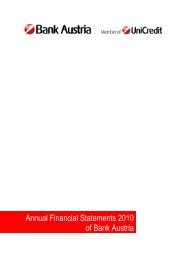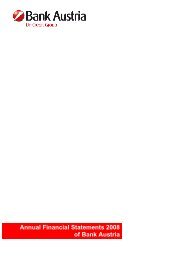Annual Financial Statements 2011 of Bank Austria
Annual Financial Statements 2011 of Bank Austria
Annual Financial Statements 2011 of Bank Austria
You also want an ePaper? Increase the reach of your titles
YUMPU automatically turns print PDFs into web optimized ePapers that Google loves.
Management Report<br />
Management Report (CONTINUED)<br />
While revenues were stable, higher operating costs (+7.0% to<br />
€ 910 m) had an impact on operating pr<strong>of</strong>it. The inclusion <strong>of</strong> small<br />
service providers in the group <strong>of</strong> consolidated companies and in the<br />
F&SME <strong>Bank</strong>ing Division (DC Elektronische Zahlungssysteme GmbH<br />
and Cards & Systems EDV-Dienstleistungs GmbH) influenced the<br />
overall picture because the relevant figures for the previous year<br />
were not recast. On the other hand, initiatives to expand our market<br />
position became effective: the sales network was strengthened with<br />
the recruitment <strong>of</strong> new employees and internal transfers to customer<br />
service units – especially in the SME sub-segment – <strong>of</strong> employees<br />
who received special training for this purpose. More over, young new<br />
employees joined the Division under the “Best Start” programme.<br />
This compares with the retransfer <strong>of</strong> a number <strong>of</strong> employees from<br />
support functions to central Competence Lines (Corporate Center).<br />
On balance, staff numbers rose by 189 FTEs (+5.0%) in <strong>2011</strong>.<br />
In <strong>2011</strong>, net write-downs <strong>of</strong> loans and provisions for guarantees<br />
and commitments in F&SME were € 161 m, down by<br />
€ 103 m or 39% from the previous year; this was the main factor<br />
contributing to pr<strong>of</strong>it growth. The cost <strong>of</strong> risk was as low as 74 basis<br />
points (bp), substantially lower than in the previous year (120 bp).<br />
This development is explained by a positive economic trend: default<br />
rates among private individuals showed a relatively favourable development,<br />
supported by economic growth and the gradual improvement<br />
in employment and incomes in <strong>Austria</strong> over the past few years.<br />
On the other hand, appreciation and depreciation <strong>of</strong> the Swiss franc<br />
had an impact additionally amplified, for methodological reasons, by<br />
a leverage effect in the development <strong>of</strong> current net additions to loan<br />
loss provisions (and in risk-weighted assets). A change in Basel 2<br />
model parameters and the switch to a quantitative model more<br />
effectively took account <strong>of</strong> these special factors. When the Swiss<br />
central bank announced an intervention threshold <strong>of</strong> 1.20 CHF/EUR<br />
on 6 September <strong>2011</strong>, exchange rate movements started to reverse.<br />
After the release <strong>of</strong> loan loss provisions in the fourth quarter <strong>of</strong><br />
<strong>2011</strong>, the provisioning charge was very low, further reducing the<br />
full-year figure. (Average RWAs in <strong>2011</strong> were also significantly lower,<br />
by 8.2%, than the comparative figure for the previous year, which<br />
reflected the strength <strong>of</strong> the Swiss franc at the time.)<br />
➔ operating pr<strong>of</strong>it in the F&SME business segment was down by<br />
€ 33 m or 11% from the previous year. As the decline in net writedowns<br />
<strong>of</strong> loans and provisions for guarantees and commitments was<br />
even larger (€ 103 m), net operating pr<strong>of</strong>it improved by € 70 m to<br />
€ 106 m compared with the previous year. The balance <strong>of</strong> non-operating<br />
items in the income statement had hardly any impact on the<br />
overall picture: provisions for risks and charges showed net income<br />
<strong>of</strong> € 4 m (after a net expense <strong>of</strong> € 7 m in 2010). Net income from<br />
investments was down by € 11 m to € 3 m, reflecting the base<br />
effect <strong>of</strong> one-<strong>of</strong>f income in the first quarter <strong>of</strong> 2010 (realised gains<br />
on the sale <strong>of</strong> shares held by a subsidiary). Pr<strong>of</strong>it before tax rose by<br />
€ 69 m to € 112 m, an increase more or less matching that in net<br />
operating pr<strong>of</strong>it.<br />
� A sharp focus on customer needs, products which are easy to<br />
understand, the employment <strong>of</strong> new means <strong>of</strong> communication and,<br />
quite generally, enhancing customer satisfaction continued to be<br />
focal areas <strong>of</strong> our activities in sales, marketing and product development<br />
in <strong>2011</strong>. In business with private customers we successfully<br />
launched a new service approach – “Smart <strong>Bank</strong>ing” – as a pilot<br />
project for about 60,000 identified target customers in Vienna.<br />
We are thereby leading customers in real-time contact from the<br />
<strong>Bank</strong> <strong>Austria</strong> app in the Apple, Android or Nokia environment towards<br />
personal dialogue with relationship managers in OnlineB@nking via<br />
telephone or SMS – around the clock and independent <strong>of</strong> branch<br />
opening hours. In this context <strong>Bank</strong> <strong>Austria</strong> achieved high activation<br />
and cross-selling rates while also relieving the workload at branches<br />
in standard business. This suggests that the new sales channel will<br />
be <strong>of</strong> major significance in the future.<br />
Other focal areas in <strong>2011</strong> were acquisition efforts based on a structured<br />
dialogue with new customers, which accompanies customers<br />
during the first year in which they are served by <strong>Bank</strong> <strong>Austria</strong>, and<br />
advertising campaigns concentrating on such topics as housing and<br />
provision for the future (insurance products). We use numerous feedback<br />
instruments aimed at customer retention. <strong>Bank</strong> <strong>Austria</strong> was the<br />
first bank in <strong>Austria</strong> to introduce feedback loops immediately after<br />
personal contacts with customers. “<strong>Bank</strong>ing without Borders“ is an<br />
initiative, initially launched at five branches, to serve foreign-language<br />
customers in their own language; in this context we <strong>of</strong>fered low-cost<br />
payment solutions in cooperation with UniCredit branches in Serbia,<br />
Croatia, Bosnia and Turkey (ethnic banking). To further enhance services<br />
provided by relationship managers to customers in the Affluent<br />
sub-segment, we made a significant investment in ongoing training<br />
in investment advisory services in cooperation with national and<br />
international institutions <strong>of</strong> higher education; 60% <strong>of</strong> relationship<br />
managers at <strong>Bank</strong> <strong>Austria</strong> have already obtained a certificate after<br />
participating in the training programme. Furthermore, we completely<br />
changed our performance incentives, switching from product-<br />
oriented sales objectives to customer satisfaction and team performance.<br />
After the integration <strong>of</strong> the SmE sub-segment (small and mediumsized<br />
enterprises) in the Family & SME Division (which was prepared<br />
in 2010 and completed at the beginning <strong>of</strong> <strong>2011</strong>), we now operate<br />
31 branches and 23 specialised outlets serving SMEs. The team <strong>of</strong><br />
relationship managers – including specialists in finance, factoring,<br />
leasing and Treasury operations – use a wide range <strong>of</strong> products.<br />
Advisory services with regard to financial planning, liquidity management<br />
and risk management are an essential component <strong>of</strong> the customer<br />
relationship. Subsidised loans, loans under the “SME Billion”<br />
lending scheme, the “Umbrella Facility”, trade finance and FX risk<br />
management are tailored to meet the needs <strong>of</strong> small and mediumsized<br />
businesses.<br />
<strong>Bank</strong> <strong>Austria</strong> · <strong>Annual</strong> <strong>Financial</strong> <strong>Statements</strong> <strong>2011</strong><br />
32
















